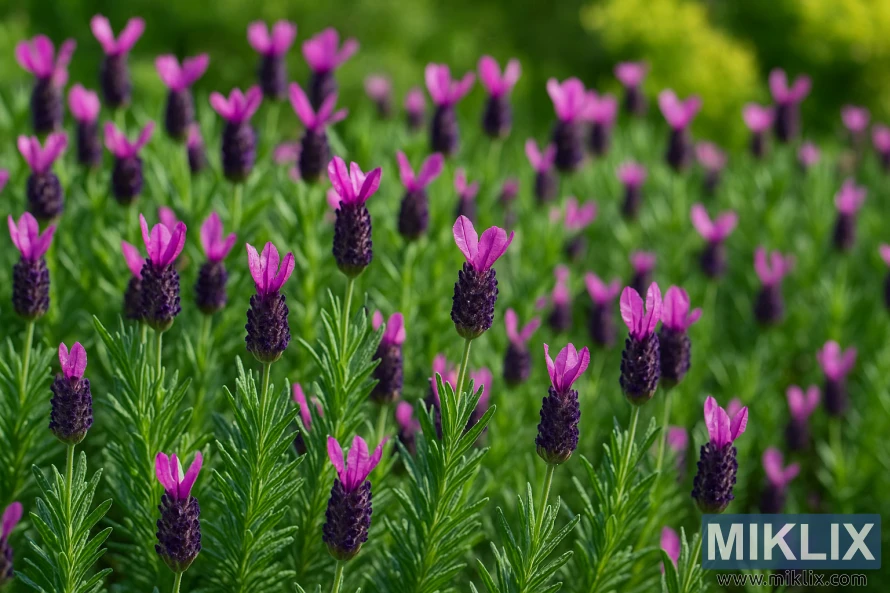Image: French Lavender with Showy Bracts and Toothed Leaves
Published: October 22, 2025 at 9:53:40 PM UTC
Discover the striking beauty of French lavender. This close-up photo captures its showy magenta bracts, textured flower spikes, and aromatic toothed foliage in vivid summer light.
This vibrant close-up photograph beautifully captures the striking beauty and distinctive character of French lavender (Lavandula stoechas), a Mediterranean species renowned for its ornate flower heads, elegant foliage, and showy bracts. The image presents a flourishing stand of French lavender varieties in full bloom under warm summer sunlight, their bold colors and sculptural forms creating a visually captivating display that epitomizes the charm of a sunny cottage or Mediterranean-style garden.
At first glance, the most eye-catching feature is the striking contrast between the dark, textured flower spikes and the flamboyant, petal-like bracts that rise from their tops. The dense, cone-shaped inflorescences are a deep violet to almost blackish-purple, their clustered florets tightly packed into a cylindrical form. Atop each flower head, a crown of vibrant magenta bracts unfurls like delicate butterfly wings, their translucent petals catching the sunlight and glowing with vivid color. These showy bracts — a defining characteristic of Lavandula stoechas — give French lavender a uniquely ornamental quality, distinguishing it from the more understated spikes of English lavender.
The foliage plays a significant supporting role in the composition. Beneath the blossoms, a dense carpet of slender, gray-green leaves fills the frame. Each leaf is distinctly toothed or serrated along the margins — a key identifying feature of French lavender — and has a slightly fuzzy texture due to the presence of fine hairs. These trichomes not only add a soft sheen under sunlight but also release aromatic oils when brushed, contributing to the plant’s famous fragrance. The cool green tones of the foliage contrast beautifully with the intense purples and pinks of the flowers, enhancing the overall vibrancy of the scene.
The photograph’s depth of field is skillfully controlled, bringing the foreground blossoms into razor-sharp focus while allowing the background plants to blur into a soft, impressionistic haze. This creates a pleasing sense of depth and visual rhythm, suggesting an expansive field of lavender stretching beyond the frame. The repetition of the flower spikes, each topped with fluttering bracts, forms a natural pattern that draws the viewer’s eye across the image, evoking the soothing continuity of a well-tended garden in full bloom.
Lighting is another essential element of this composition. The warm, golden rays of summer sunlight illuminate the scene, enhancing the saturated colors of the blossoms and casting gentle shadows that accentuate their three-dimensional form. The interplay of light and texture highlights the delicate veining of the bracts and the intricate structure of the inflorescences, while also bringing out the subtle silvery tones of the foliage.
This image captures more than just the physical beauty of French lavender — it conveys the sensory richness of a garden alive with life and fragrance. One can almost feel the gentle warmth of the sun, hear the hum of bees drawn to the nectar-rich blooms, and breathe in the sweet, resinous scent that defines Mediterranean landscapes. French lavender is not only visually striking but also ecologically valuable, attracting pollinators and thriving in dry, sunny conditions where other plants struggle. Its distinctive combination of sculptural flowers, aromatic foliage, and vibrant color make it a beloved choice for ornamental borders, wildlife gardens, and sensory planting schemes alike.
The image is related to: A Guide to the Most Beautiful Lavender Varieties to Grow in Your Garden

